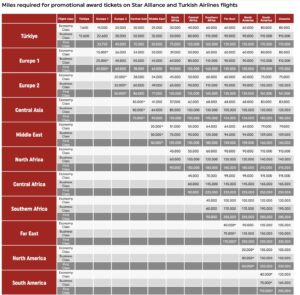
The Miles & Smiles loyalty program from Turkish Airlines offers one of the most valuable, yet often challenging, opportunities for award flight redemptions. The airline itself has a network of 400 aircraft flying to over 120 countries, while the loyalty program is a transfer partner for BILT, Capital One, and Citi. Through the Miles & Smiles program, customers are able to access multiple “sweet spots” in the “zone-based” award charts. However, an upcoming devaluation has customers racing to finalize award bookings.
Turkish Airlines Publishes A New Award Chart
As reported by Prince of Travel, Turkish Airlines published a new award chart on its website, which indicates a significant devaluation of the award redemption rates through the Miles & Smiles program. This devaluation affects all award redemptions including both Turkish Airlines and Star Alliance partner redemptions as well as a departure from the historic “zone-based” award chart.

Credit. Turkish Airlines. Business Class.
The Turkish Airlines Devaluation Impact On Award Rates
The impact of the devaluation for award redemptions is slightly complex, but here is a simple way to bucket the changes:
- Direct Flights With Turkish Airlines (New Award Chart)
- Direct Flights With Star Alliance Partners (New Award Chart)
- 1+ Stop Flights With Turkish Airlines Or Star Alliance Partners (New Methodology)
Direct Flights With Turkish Airlines And Star Alliance Partners
Previously, Turkish Airlines published a single saver award chart for both Turkish Airlines and Star Alliance partner redemptions. As part of the devaluation, Turkish Airlines split the saver award chart and published individual redemption rates for Turkish Airlines and Star Alliance partners respectively. Here are a couple examples which demonstrate the impact of the devaluation on traditional “sweet spot” award redemptions via the Turkish Airlines Miles & Smiles program:
United States To Turkey (With Turkish Airlines)
- Economy (old) – 30,000 points vs Economy (new) – 40,000 points
- Business (old) – 45,000 points vs Business (new) – 65,000 points
United States To Europe (With Star Alliance Partner)
- Economy (old) – 30,000 points vs Economy (new) – 50,000 points
- Business (old) – 45,000 points vs Business (new) – 85,000 points
United States To Hawaii (With United Airlines)
- Economy (old) – 7,500 points vs Economy (new) – 10,000 points
- Business (old) – 12,500 points vs Business (new) – 15,000 points

Credit. Turkish Airlines. Miles & Smiles Saver Award Chart – Turkish Airlines & Star Alliance Partners (Old).

Credit. Turkish Airlines. Miles & Smiles Award Chart – Turkish Airlines (New).

Credit. Turkish Airlines. Miles & Smiles Award Chart – Star Alliance Partners (New)

Credit. Turkish Airlines. Miles & Smiles Award Chart – Domestic Star Alliance Partners (New)
1-Stop Flights With Turkish Airlines And Star Alliance Partners
With the devaluation, Turkish Airlines is removing “zone-based” award redemptions and implementing “segment-based” or “additive” award redemptions. In a “zone-based” award redemption, the redemption rate is based on the origin and destination locations, regardless of any connection locations. This means that a flight between North American and Europe, with a connection in Turkey, is priced as a flight between North American and Europe on the award chart. However, in a “segment-based” or “additive” award redemption, each flight segment is priced individually, then added together for the total award redemption rate. Here is an example which demonstrates the impact of this change:
United States To Greece, Via Istanbul (With Turkish Airlines)
- Economy (old) – 30,000 points vs Economy (new) – 50,000 points (40,000 + 10,000)
- Business (old) – 45,000 points vs Business (new) – 85,000 points (65,000 + 20,000)

Credit. Turkish Airlines. Award Ticket Calculation.
Final Thoughts
There is no way to sugar coat the message: this devaluation is brutal. While some routes see a relatively small impact to award redemption rates, other routes see a near doubling of the redemption rate. With that said, despite the devaluation, the United Airlines “sweet spot” route to Hawaii is an incredible deal, as it still gets priced as a “domestic” flight in the new award chart, despite the distance. On a slightly positive note, even though the new award chart is published, the new award rates do not yet appear in the Miles & Smiles portal. Book now!